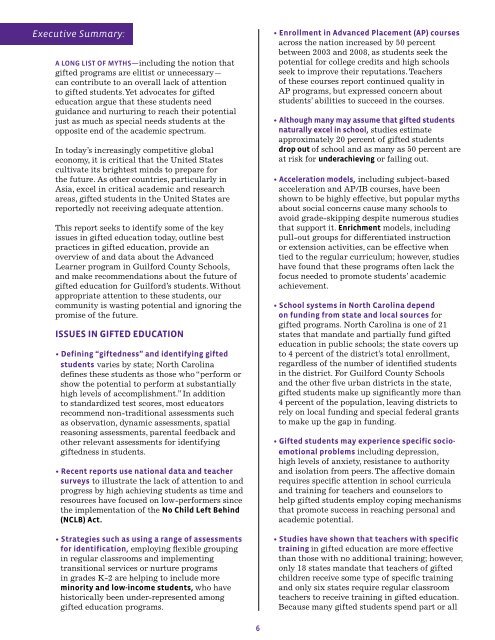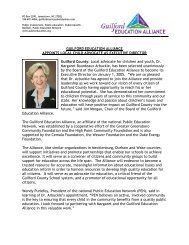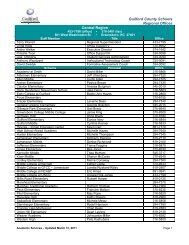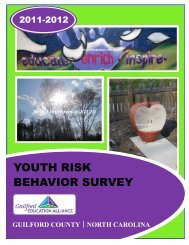2009 Advancing Excellence: A Report on Gifted Education - Guilford ...
2009 Advancing Excellence: A Report on Gifted Education - Guilford ...
2009 Advancing Excellence: A Report on Gifted Education - Guilford ...
You also want an ePaper? Increase the reach of your titles
YUMPU automatically turns print PDFs into web optimized ePapers that Google loves.
Executive Summary:<br />
A l<strong>on</strong>g list of myths—including the noti<strong>on</strong> that<br />
gifted programs are elitist or unnecessary—<br />
can c<strong>on</strong>tribute to an overall lack of attenti<strong>on</strong><br />
to gifted students. Yet advocates for gifted<br />
educati<strong>on</strong> argue that these students need<br />
guidance and nurturing to reach their potential<br />
just as much as special needs students at the<br />
opposite end of the academic spectrum.<br />
In today’s increasingly competitive global<br />
ec<strong>on</strong>omy, it is critical that the United States<br />
cultivate its brightest minds to prepare for<br />
the future. As other countries, particularly in<br />
Asia, excel in critical academic and research<br />
areas, gifted students in the United States are<br />
reportedly not receiving adequate attenti<strong>on</strong>.<br />
This report seeks to identify some of the key<br />
issues in gifted educati<strong>on</strong> today, outline best<br />
practices in gifted educati<strong>on</strong>, provide an<br />
overview of and data about the Advanced<br />
Learner program in <strong>Guilford</strong> County Schools,<br />
and make recommendati<strong>on</strong>s about the future of<br />
gifted educati<strong>on</strong> for <strong>Guilford</strong>’s students. Without<br />
appropriate attenti<strong>on</strong> to these students, our<br />
community is wasting potential and ignoring the<br />
promise of the future.<br />
Issues in <strong>Gifted</strong> Educati<strong>on</strong><br />
• Defining “giftedness” and identifying gifted<br />
students varies by state; North Carolina<br />
defines these students as those who “perform or<br />
show the potential to perform at substantially<br />
high levels of accomplishment.” In additi<strong>on</strong><br />
to standardized test scores, most educators<br />
recommend n<strong>on</strong>-traditi<strong>on</strong>al assessments such<br />
as observati<strong>on</strong>, dynamic assessments, spatial<br />
reas<strong>on</strong>ing assessments, parental feedback and<br />
other relevant assessments for identifying<br />
giftedness in students.<br />
• Recent reports use nati<strong>on</strong>al data and teacher<br />
surveys to illustrate the lack of attenti<strong>on</strong> to and<br />
progress by high achieving students as time and<br />
resources have focused <strong>on</strong> low-performers since<br />
the implementati<strong>on</strong> of the No Child Left Behind<br />
(NCLB) Act.<br />
• Strategies such as using a range of assessments<br />
for identificati<strong>on</strong>, employing flexible grouping<br />
in regular classrooms and implementing<br />
transiti<strong>on</strong>al services or nurture programs<br />
in grades K-2 are helping to include more<br />
minority and low-income students, who have<br />
historically been under-represented am<strong>on</strong>g<br />
gifted educati<strong>on</strong> programs.<br />
• Enrollment in Advanced Placement (AP) courses<br />
across the nati<strong>on</strong> increased by 50 percent<br />
between 2003 and 2008, as students seek the<br />
potential for college credits and high schools<br />
seek to improve their reputati<strong>on</strong>s. Teachers<br />
of these courses report c<strong>on</strong>tinued quality in<br />
AP programs, but expressed c<strong>on</strong>cern about<br />
students’ abilities to succeed in the courses.<br />
• Although many may assume that gifted students<br />
naturally excel in school, studies estimate<br />
approximately 20 percent of gifted students<br />
drop out of school and as many as 50 percent are<br />
at risk for underachieving or failing out.<br />
• Accelerati<strong>on</strong> models, including subject-based<br />
accelerati<strong>on</strong> and AP/IB courses, have been<br />
shown to be highly effective, but popular myths<br />
about social c<strong>on</strong>cerns cause many schools to<br />
avoid grade-skipping despite numerous studies<br />
that support it. Enrichment models, including<br />
pull-out groups for differentiated instructi<strong>on</strong><br />
or extensi<strong>on</strong> activities, can be effective when<br />
tied to the regular curriculum; however, studies<br />
have found that these programs often lack the<br />
focus needed to promote students’ academic<br />
achievement.<br />
• School systems in North Carolina depend<br />
<strong>on</strong> funding from state and local sources for<br />
gifted programs. North Carolina is <strong>on</strong>e of 21<br />
states that mandate and partially fund gifted<br />
educati<strong>on</strong> in public schools; the state covers up<br />
to 4 percent of the district’s total enrollment,<br />
regardless of the number of identified students<br />
in the district. For <strong>Guilford</strong> County Schools<br />
and the other five urban districts in the state,<br />
gifted students make up significantly more than<br />
4 percent of the populati<strong>on</strong>, leaving districts to<br />
rely <strong>on</strong> local funding and special federal grants<br />
to make up the gap in funding.<br />
• <strong>Gifted</strong> students may experience specific socioemoti<strong>on</strong>al<br />
problems including depressi<strong>on</strong>,<br />
high levels of anxiety, resistance to authority<br />
and isolati<strong>on</strong> from peers. The affective domain<br />
requires specific attenti<strong>on</strong> in school curricula<br />
and training for teachers and counselors to<br />
help gifted students employ coping mechanisms<br />
that promote success in reaching pers<strong>on</strong>al and<br />
academic potential.<br />
• Studies have shown that teachers with specific<br />
training in gifted educati<strong>on</strong> are more effective<br />
than those with no additi<strong>on</strong>al training; however,<br />
<strong>on</strong>ly 18 states mandate that teachers of gifted<br />
children receive some type of specific training<br />
and <strong>on</strong>ly six states require regular classroom<br />
teachers to receive training in gifted educati<strong>on</strong>.<br />
Because many gifted students spend part or all<br />
of the school day in heterogeneous classrooms,<br />
all teachers need training <strong>on</strong> how to recognize<br />
and teach advanced learners and to develop<br />
potential giftedness.<br />
Best Practices in <strong>Gifted</strong> Educati<strong>on</strong><br />
THE NATIONAL ASSOCIATION FOR GIFTED CHILDREN (NAGC)<br />
established standards in 1998 that are widely<br />
accepted as nati<strong>on</strong>al guidelines am<strong>on</strong>g experts<br />
in gifted educati<strong>on</strong>. In <str<strong>on</strong>g>2009</str<strong>on</strong>g>, the Academically<br />
or Intellectually <strong>Gifted</strong> (AIG) office at the N.C.<br />
Department of Public Instructi<strong>on</strong> developed new<br />
state performance standards for AIG programs,<br />
using the NAGC standards as a reference.<br />
In accordance with the standards from the<br />
N.C. Department of Public Instructi<strong>on</strong> and<br />
the Superintendent’s Strategic Plan, the AL<br />
department in <strong>Guilford</strong> County Schools will<br />
begin implementing a new plan in the fall of<br />
2010, with the following key desired results:<br />
• Increased student performance and<br />
participati<strong>on</strong> <strong>on</strong> AP exams, increased<br />
performance <strong>on</strong> EOGs and EOCs.<br />
• Increased rigor for Advanced Learners at all<br />
levels through the most challenging curricula that<br />
is aligned to the NC Standard Course of Study.<br />
• Improve teacher performance and instructi<strong>on</strong><br />
skills in accelerated learning activities.<br />
• Increased minority student involvement and<br />
readiness for AL eligibility and AP coursework.<br />
• Increase the number of AL certified teachers.<br />
• Improve transiti<strong>on</strong>s between elementary and<br />
middle school to high school.<br />
Nati<strong>on</strong>al Associati<strong>on</strong> for <strong>Gifted</strong> Children<br />
Standards<br />
1. <strong>Gifted</strong> educati<strong>on</strong> services must include<br />
curricular and instructi<strong>on</strong>al opportunities<br />
directed to the unique needs of the gifted learner.<br />
2. Appropriate gifted educati<strong>on</strong> programming<br />
must include the establishment of a systematic<br />
means of developing, implementing and<br />
managing services.<br />
3. The development of appropriate gifted<br />
educati<strong>on</strong> programming requires comprehensive<br />
services based <strong>on</strong> sound philosophical,<br />
theoretical and empirical support.<br />
4. Program evaluati<strong>on</strong> is the systematic study of<br />
the value and impact of services provided.<br />
5. <strong>Gifted</strong> educati<strong>on</strong> programming must establish<br />
a plan to recognize and nurture the unique socioemoti<strong>on</strong>al<br />
development of gifted learners.<br />
6. <strong>Gifted</strong> learners are entitled to be served by<br />
professi<strong>on</strong>als who have specialized preparati<strong>on</strong><br />
in gifted educati<strong>on</strong>, expertise in appropriate<br />
differentiated c<strong>on</strong>tent and instructi<strong>on</strong>al<br />
methods, involvement in <strong>on</strong>going professi<strong>on</strong>al<br />
development, and who possess exemplary<br />
pers<strong>on</strong>al and professi<strong>on</strong>al traits.<br />
7. <strong>Gifted</strong> learners must be assessed to determine<br />
appropriate educati<strong>on</strong> services.<br />
North Carolina Department of Public<br />
Instructi<strong>on</strong> Standards<br />
1. The LEA’s* student identificati<strong>on</strong> procedures for<br />
AIG** are clear, equitable, and comprehensive<br />
and lead towards appropriate educati<strong>on</strong>al services.<br />
2. The LEA employs challenging, rigorous, and<br />
relevant curriculum and instructi<strong>on</strong> K-12 to<br />
accommodate a range of academic, intellectual,<br />
social, and emoti<strong>on</strong>al needs of gifted learners.<br />
3. The LEA recruits and retains highly qualified<br />
professi<strong>on</strong>als and provides relevant and effective<br />
professi<strong>on</strong>al development c<strong>on</strong>cerning the<br />
needs of gifted learners that is <strong>on</strong>-going and<br />
comprehensive.<br />
4. The LEA provides an array of K-12 programs<br />
and services by the total school community to<br />
meet the diverse academic, intellectual, social,<br />
and emoti<strong>on</strong>al needs of gifted learners.<br />
5. The LEA ensures <strong>on</strong>-going and meaningful<br />
participati<strong>on</strong> of stakeholders in the planning<br />
and implementati<strong>on</strong> of the local AIG program to<br />
develop str<strong>on</strong>g partnerships.<br />
6. The LEA implements, m<strong>on</strong>itors, and evaluates<br />
the local AIG program and plan to ensure that<br />
all programs and services are effective in meeting<br />
the academic, intellectual, social, and emoti<strong>on</strong>al<br />
needs of gifted learners.<br />
Recommended Acti<strong>on</strong>s:<br />
1. Make use of available data to m<strong>on</strong>itor program<br />
effectiveness and ensure academic accountability<br />
for all students.<br />
2. Prepare teachers and principals to work<br />
effectively and creatively with advanced students<br />
at all levels.<br />
3. Help parents be effective advocates for their<br />
advanced children.<br />
4. Ensure that the curriculum offers the broad<br />
range of services required to meet the needs of<br />
advanced students at all levels.<br />
5. Cultivate the potential for advanced<br />
achievement am<strong>on</strong>g under-served populati<strong>on</strong>s.<br />
*LEA: Local Educati<strong>on</strong> Agency<br />
**AIG: Academically or Intellectually <strong>Gifted</strong><br />
6 7












